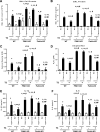PINK1 mediates the protective effects of thyroid hormone T3 in hyperoxia-induced lung injury
- PMID: 33851544
- PMCID: PMC8285622
- DOI: 10.1152/ajplung.00598.2020
PINK1 mediates the protective effects of thyroid hormone T3 in hyperoxia-induced lung injury
Abstract
Hyperoxia can lead to respiratory failure and death. Our previous work demonstrates that oxidant and mitochondrial injury play a critical role in hyperoxia-induced acute lung injury (HALI). Recently, thyroid hormone has been demonstrated to promote mitochondrial survival in other models of lung injury, but its role in hyperoxia is unknown. Adult wild-type (WT) mice were pretreated with either nebulized triiodothyronine (T3, 40 μg/kg) for 1 or 3 days, or with propylthiouracil (PTU, 100 μg/kg), for 3 days. Following pretreatment, WT mice underwent 72 h of hyperoxia exposure. WT and PINK1-/- mice were pretreated with either nebulized T3 (40 μg/kg) for 3 days or no pretreatment before 72 h continuous hyperoxia exposure. Bronchoalveolar lavage (BAL), histological changes in cellular composition, and type I cytokine induction were assessed. Lung lysates for mitochondrial cellular bioenergetics markers were analyzed by Western blot. Hyperoxia caused a significant increase in BAL total cell counts and lung cellular infiltrates. Administration of PTU enhanced HALI, whereas T3 attenuated HALI, inflammation, and oxidants in WT mice. In addition, T3 pretreatment increased mitochondrial biogenesis/fusion/mitophagy and decreased ER stress and apoptosis. PINK1-/- mice were more susceptible to hyperoxia than WT mice. Notably, pretreatment with T3 did not attenuate HALI in PINK1-/- mice. In addition, T3 pretreatment increased mitochondrial anti-ROS potential, improved mitochondrial bioenergetics and mitophagy, and attenuated mitochondria-regulated apoptosis, all in a PINK1-dependent manner. Our results highlight a novel protective role for PINK1 in mediating the cytoprotective effects of thyroid hormone in HALI. Therefore, thyroid hormone may represent a potential therapy for ALI.
Keywords: HALI; PINK1; hyperoxia; lung injury; thyroid hormone.
Conflict of interest statement
Y.Z., G.Y., N.K., and P.J.L. have IP on the use of thyroid hormone mimetics in IPF and ARDS licensed to biotechnology. There are no conflicts of interest, financial or otherwise, to disclose.
Figures







Similar articles
-
Nitrated fatty acid, 10-nitrooleate protects against hyperoxia-induced acute lung injury in mice.Int Immunopharmacol. 2022 Aug;109:108838. doi: 10.1016/j.intimp.2022.108838. Epub 2022 May 11. Int Immunopharmacol. 2022. PMID: 35561478
-
Endothelial PINK1 mediates the protective effects of NLRP3 deficiency during lethal oxidant injury.J Immunol. 2014 Jun 1;192(11):5296-304. doi: 10.4049/jimmunol.1400653. Epub 2014 Apr 28. J Immunol. 2014. PMID: 24778451 Free PMC article.
-
Autophagy, TERT, and mitochondrial dysfunction in hyperoxia.Am J Physiol Heart Circ Physiol. 2021 Nov 1;321(5):H985-H1003. doi: 10.1152/ajpheart.00166.2021. Epub 2021 Sep 24. Am J Physiol Heart Circ Physiol. 2021. PMID: 34559580 Free PMC article.
-
Molecular mechanisms of hyperoxia-induced acute lung injury.Front Biosci. 2008 May 1;13:6653-61. doi: 10.2741/3179. Front Biosci. 2008. PMID: 18508685 Review.
-
Cytokines in tolerance to hyperoxia-induced injury in the developing and adult lung.Free Radic Biol Med. 2006 Jul 1;41(1):4-18. doi: 10.1016/j.freeradbiomed.2006.01.027. Epub 2006 Feb 17. Free Radic Biol Med. 2006. PMID: 16781448 Review.
Cited by
-
Thyroid hormone modulates hyperoxic neonatal lung injury and mitochondrial function.JCI Insight. 2023 Apr 24;8(8):e160697. doi: 10.1172/jci.insight.160697. JCI Insight. 2023. PMID: 36917181 Free PMC article.
-
Mitochondria and their potential role in acute lung injury (Review).Exp Ther Med. 2022 Jun 1;24(1):479. doi: 10.3892/etm.2022.11406. eCollection 2022 Jul. Exp Ther Med. 2022. PMID: 35761815 Free PMC article. Review.
-
Regulated programmed cell death in acute lung injury: from pathogenesis to therapy.Front Immunol. 2025 Jul 23;16:1630015. doi: 10.3389/fimmu.2025.1630015. eCollection 2025. Front Immunol. 2025. PMID: 40771815 Free PMC article. Review.
-
Protective Action of 3,5-Diiodo-L-Thyronine on Cigarette Smoke-Induced Mitochondrial Dysfunction in Human Alveolar Epithelial Cells.Biomedicines. 2025 Apr 22;13(5):1014. doi: 10.3390/biomedicines13051014. Biomedicines. 2025. PMID: 40426844 Free PMC article.
-
Inhibition of macrophage inflammasome assembly and pyroptosis with GC-1 ameliorates acute lung injury.Theranostics. 2025 Jan 20;15(6):2360-2374. doi: 10.7150/thno.101866. eCollection 2025. Theranostics. 2025. PMID: 39990234 Free PMC article.
References
-
- Yau WW, Singh BK, Lesmana R, Zhou J, Sinha RA, Wong KA, Wu Y, Bay B-H, Sugii S, Sun L, Yen PM. Thyroid hormone (T3) stimulates brown adipose tissue activation via mitochondrial biogenesis and MTOR-mediated mitophagy. Autophagy 15: 131–150, 2019. doi:10.1080/15548627.2018.1511263. - DOI - PMC - PubMed
Publication types
MeSH terms
Substances
Grants and funding
LinkOut - more resources
Full Text Sources
Other Literature Sources
Molecular Biology Databases

